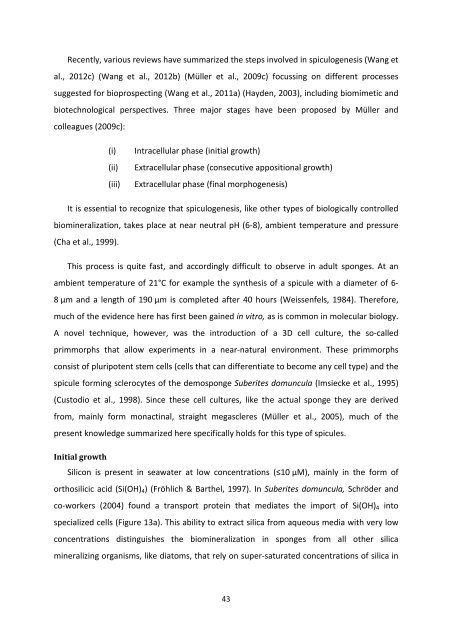MASTER THESIS Biomimetic potential of sponge ... - IAP/TU Wien
MASTER THESIS Biomimetic potential of sponge ... - IAP/TU Wien
MASTER THESIS Biomimetic potential of sponge ... - IAP/TU Wien
You also want an ePaper? Increase the reach of your titles
YUMPU automatically turns print PDFs into web optimized ePapers that Google loves.
Recently, various reviews have summarized the steps involved in spiculogenesis (Wang et<br />
al., 2012c) (Wang et al., 2012b) (Müller et al., 2009c) focussing on different processes<br />
suggested for bioprospecting (Wang et al., 2011a) (Hayden, 2003), including biomimetic and<br />
biotechnological perspectives. Three major stages have been proposed by Müller and<br />
colleagues (2009c):<br />
(i)<br />
(ii)<br />
(iii)<br />
Intracellular phase (initial growth)<br />
Extracellular phase (consecutive appositional growth)<br />
Extracellular phase (final morphogenesis)<br />
It is essential to recognize that spiculogenesis, like other types <strong>of</strong> biologically controlled<br />
biomineralization, takes place at near neutral pH (6-8), ambient temperature and pressure<br />
(Cha et al., 1999).<br />
This process is quite fast, and accordingly difficult to observe in adult <strong>sponge</strong>s. At an<br />
ambient temperature <strong>of</strong> 21°C for example the synthesis <strong>of</strong> a spicule with a diameter <strong>of</strong> 6-<br />
8 µm and a length <strong>of</strong> 190 µm is completed after 40 hours (Weissenfels, 1984). Therefore,<br />
much <strong>of</strong> the evidence here has first been gained in vitro, as is common in molecular biology.<br />
A novel technique, however, was the introduction <strong>of</strong> a 3D cell culture, the so-called<br />
primmorphs that allow experiments in a near-natural environment. These primmorphs<br />
consist <strong>of</strong> pluripotent stem cells (cells that can differentiate to become any cell type) and the<br />
spicule forming sclerocytes <strong>of</strong> the demo<strong>sponge</strong> Suberites domuncula (Imsiecke et al., 1995)<br />
(Custodio et al., 1998). Since these cell cultures, like the actual <strong>sponge</strong> they are derived<br />
from, mainly form monactinal, straight megascleres (Müller et al., 2005), much <strong>of</strong> the<br />
present knowledge summarized here specifically holds for this type <strong>of</strong> spicules.<br />
Initial growth<br />
Silicon is present in seawater at low concentrations (≤10 µM), mainly in the form <strong>of</strong><br />
orthosilicic acid (Si(OH) 4 ) (Fröhlich & Barthel, 1997). In Suberites domuncula, Schröder and<br />
co-workers (2004) found a transport protein that mediates the import <strong>of</strong> Si(OH) 4 into<br />
specialized cells (Figure 13a). This ability to extract silica from aqueous media with very low<br />
concentrations distinguishes the biomineralization in <strong>sponge</strong>s from all other silica<br />
mineralizing organisms, like diatoms, that rely on super-saturated concentrations <strong>of</strong> silica in<br />
43

















